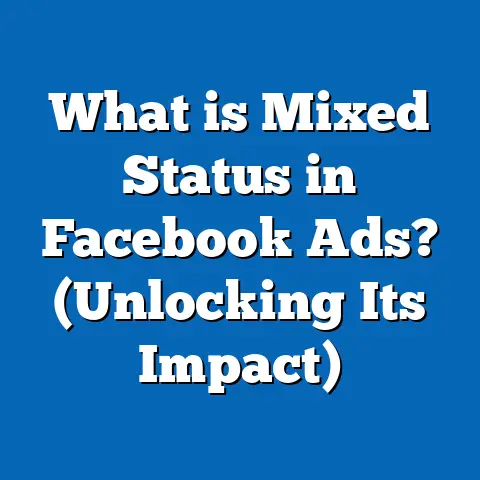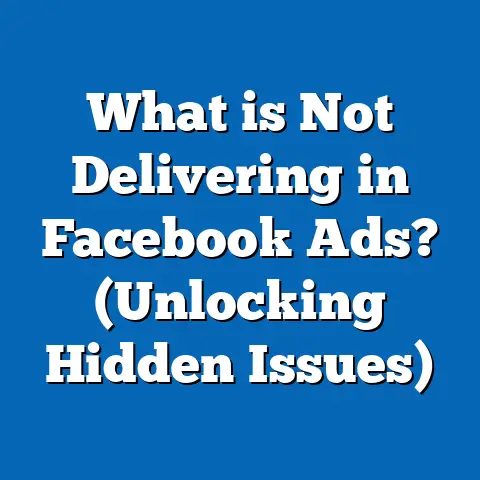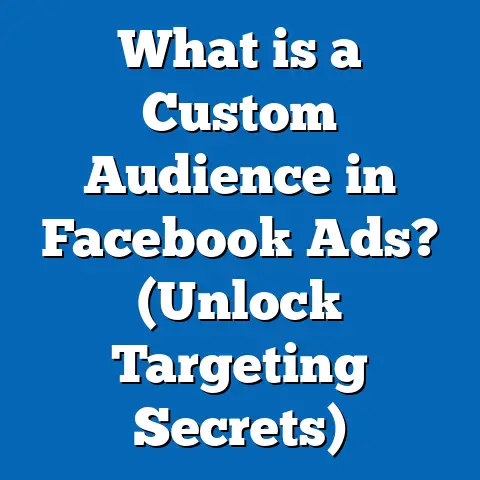What is VTS? (Unraveling Its Role in Facebook Ads)
What is VTS? (Unraveling Its Role in Facebook Ads)
Introduction: Pet-Friendly Choices and Smart Advertising
In today’s consumer landscape, pet ownership has soared, with over 70% of U.S. households owning a pet as of 2024. This shift has created a dynamic market for pet-friendly products and services—from organic pet food to luxury grooming salons. For businesses targeting this passionate audience, Facebook Ads remain a prime platform.
To cut through the noise and reach those pet lovers who matter most, marketers need more than just basic targeting. The Value-Based Targeting System (VTS) emerges as a powerful tool that allows advertisers to focus on users who are not only interested but are likely to bring the highest value to their business.
This guide dives deep into what VTS is, how it functions within Facebook Ads, and why mastering it can transform your marketing results.
Understanding VTS: The Basics
What Does VTS Stand For?
VTS means Value-Based Targeting System. Unlike traditional targeting based on demographics or interests alone, VTS uses predictive analytics to prioritize audiences based on their expected value to your business.
This means the system doesn’t just find people who might click on your ad but focuses on those more likely to make purchases, become loyal customers, or drive high lifetime value.
Why Is VTS Important in Facebook Ads?
Facebook Ads offers multiple targeting options. However, many advertisers waste money targeting broad groups that generate low returns. VTS addresses this by:
- Helping you focus your budget on users with the highest potential value.
- Reducing cost per acquisition (CPA) by avoiding low-value clicks.
- Increasing overall return on ad spend (ROAS).
Especially for businesses in competitive niches like pet products, where margins might be tight, prioritizing quality over quantity in ad targeting is crucial.
How VTS Works: The Science Behind the System
Data-Driven Audience Segmentation
VTS uses vast amounts of data collected from Facebook user behaviors and interactions with ads and websites. It segments audiences by analyzing:
- Past purchase history.
- Engagement with similar products.
- Frequency of interactions.
- Website visit patterns.
This segmentation is dynamic; it evolves as new data comes in.
Machine Learning Algorithms
Facebook’s AI models run complex algorithms that:
- Score users based on their predicted future behavior.
- Continuously update these scores as new behaviors occur.
- Identify patterns unseen by human analysts.
These algorithms integrate data from multiple sources — including Facebook Pixel and Conversion API — to create a comprehensive user profile.
Integration with Facebook Pixel and Conversion API
Facebook Pixel tracks actions users take after clicking on your ads — such as purchases or sign-ups. The Conversion API supplements this by sending server-side data directly to Facebook, improving data accuracy even when browser tracking is limited.
Together, they feed critical information into the VTS algorithms, making predictions more accurate.
Data-Backed Insights on VTS Effectiveness
Increased ROI with Value-Based Targeting
According to Facebook’s internal data (2023):
- Advertisers using VTS see up to 40% higher ROAS compared to campaigns without value-based optimization.
- Conversion rates improve by 20-30%, meaning more sales per ad dollar spent.
Industry-Wide Statistics
- E-commerce brands that implemented VTS reported an average 15% reduction in CPA.
- Niche markets like pet care saw 35% higher engagement rates when ads targeted high-value prospects identified by VTS.
Case Study: Pet Supply Brand Success Story
Background: A mid-sized pet supply retailer struggled with high ad costs and low conversion rates using traditional targeting.
Approach: They integrated VTS by:
- Installing Facebook Pixel and Conversion API.
- Uploading customer purchase data for custom audience creation.
- Running VTS-optimized campaigns focusing on high-value segments.
Results after 3 months:
- Online sales rose by 35%.
- Advertising costs dropped by 15% due to precise targeting.
- Customer retention improved with personalized remarketing.
This case highlights how VTS can transform ad efficiency and profitability.
Differentiating VTS from Other Facebook Ad Targeting Options
Traditional Targeting vs. Value-Based Targeting
| Targeting Type | Focus | Strengths | Limitations |
|---|---|---|---|
| Interest-Based Targeting | User interests and demographics | Easy setup; broad reach | Less precision; higher waste |
| Lookalike Audiences | Similarity to existing customers | Expands reach efficiently | Dependent on source audience quality |
| Value-Based Targeting | Predicted customer value | Optimizes for long-term ROI | Requires detailed data inputs |
Value-Based Targeting goes beyond demographics or interests by focusing on customer profitability rather than just likelihood to convert once.
When to Use Each?
- Use interest-based targeting for brand awareness or reaching new audiences.
- Use lookalike audiences when you have a good customer base but want to scale reach.
- Use VTS when your goal is maximizing revenue from the best customers and improving campaign efficiency.
Technical Concepts Explained Simply
What is Customer Lifetime Value (CLV)?
CLV estimates the total revenue a customer will bring during their relationship with your brand. It accounts for:
- Initial purchase value.
- Repeat purchase behavior.
- Average order sizes.
Facebook’s VTS uses CLV predictions to target users who are likely to bring the highest CLV.
How Does Facebook Use Predictive Analytics?
Predictive analytics use past behavior and machine learning models to forecast:
- Which users might buy next?
- How much they might spend?
- Their likelihood to remain loyal customers.
This forecasting powers the selection of high-value targets.
Practical Applications of VTS in Facebook Ads
Example 1: Pet Grooming Services
A local pet grooming service wants more bookings from loyal clients:
- Using VTS, they target users who previously booked appointments or engaged with grooming posts.
- They exclude users unlikely to convert based on low engagement or purchase history.
Result: Higher booking rates at lower ad costs.
Example 2: Premium Pet Food Brands
Premium pet food brands can:
- Use VTS to identify users who regularly buy high-end products.
- Deliver ads showcasing exclusive deals or new premium items to these users.
Result: Improved sales for higher-margin products and increased customer loyalty.
Example 3: Pet Accessories Retailer
A retailer of pet toys and accessories:
- Uploads customer purchase data for custom audiences.
- Uses VTS to focus on users who tend to buy multiple items or shop seasonally (holidays).
Result: Increased average order value (AOV) due to targeted upselling efforts.
Advanced Strategies for Using VTS Effectively
Combining VTS with Dynamic Creative Ads
Dynamic creative ads automatically generate multiple ad variations using different images, headlines, and calls-to-action.
When paired with VTS:
- High-value users see personalized product recommendations.
- Campaigns adjust in real-time based on which combinations perform best for different segments.
This leads to higher engagement and conversions.
Leveraging Retargeting Campaigns
Retargeting with VTS means focusing follow-up ads on users who showed interest but didn’t convert — particularly those predicted to be high-value customers.
For example:
- A pet toy brand retargets cart abandoners prioritized by predicted CLV.
This approach reduces wasted impressions and increases conversion chances significantly.
Multi-Touch Attribution Models
VTS supports multi-touch attribution — understanding which ad touchpoints contribute most to a conversion over time, helping optimize budget allocation towards the most effective channels.
Implementing VTS Step-by-Step
Step 1: Set Up Facebook Pixel & Conversion API
Ensure proper installation of these tools on your website for accurate tracking of user behavior and sales events.
Step 2: Collect and Upload Customer Data
Use CRM data (purchases, frequency, order value) to create custom audiences for Facebook to analyze and build value models.
Step 3: Create Value-Based Custom Audiences
Define segments based on customer lifetime value or repeat purchase likelihood using your uploaded data combined with Facebook’s modeling.
Step 4: Build Campaigns Using VTS Audiences
Set up campaigns targeting these high-value segments. Use conversion objectives aligned with your business goals (e.g., purchases or leads).
Step 5: Monitor Campaign Performance & Adjust
Track KPIs such as ROAS, CPA, conversion rate, and adjust bid strategies or creatives based on performance insights.
Solution: Adopted VTS targeting users with high predicted CLV based on previous orders tracked via Pixel.
Outcome:
- CPA decreased by 22%.
- ROAS increased by 45% within six months.
- Repeat purchases increased by 30% due to better retargeting.
Case Study #2: Boutique Pet Grooming Salon
Challenge: Local competition made client acquisition expensive.
Solution: Used VTS combined with local geo-targeting and lookalike audiences based on high-value clients.
Outcome:
- New bookings up by 40%.
- Customer retention improved with personalized follow-up ads.
Comparing VTS with Other Platforms’ Targeting Systems
| Platform | Targeting Approach | Unique Features | Best For |
|---|---|---|---|
| Facebook (VTS) | Predictive customer value scoring | Deep behavioral data integration | B2C industries; niche markets |
| Google Ads | Keyword intent + audience segments | Search intent focus | Direct intent-driven purchases |
| LinkedIn Ads | Professional demographics | Job titles, industries | B2B marketing |
Facebook’s strength lies in its rich social interaction data combined with purchase tracking, making VTS especially effective in retail or consumer goods sectors like pet products.
Industry Trends Impacting VTS
Privacy Regulations & Impact on Data Collection
With new privacy laws such as GDPR (Europe) and CCPA (California), user tracking faces restrictions:
- Facebook’s shift towards aggregated event measurement helps maintain targeting accuracy while respecting privacy.
- Advertisers need transparent consent mechanisms to keep Pixel data flowing effectively into VTS models.
AI & Automation Enhancements
Recent upgrades in AI mean:
- Smarter audience predictions with reduced manual input.
- Automated budget allocation focusing on highest performing segments identified by VTS.
Marketers should leverage these improvements for better scalability and efficiency.
Common Challenges & Solutions When Using VTS
| Challenge | Solution |
|---|---|
| Insufficient customer data | Collect more first-party data; encourage repeat purchases |
| Incorrect Pixel setup | Use Facebook’s diagnostic tools; verify events |
| High competition causing cost spikes | Refine audiences; use layered targeting |
| Privacy changes reducing tracking accuracy | Use server-side tracking & Conversion API |
Tips for Maximizing VTS Benefits in Your Campaigns
- Regularly Update Customer Data: Keep your custom audiences refreshed with recent purchase info.
- Use Tiered Audience Segments: Differentiate between medium-value and high-value users for personalized messaging.
- Test Multiple Creatives: See what resonates best with each segment identified by VTS.
- Leverage Lookalike Audiences Based on High-Value Users: Expand reach while maintaining quality.
- Monitor Frequency: Avoid overexposing high-value users to ads which can cause fatigue.
Final Thoughts: Next Steps for Marketers & Business Owners
VTS represents a shift towards smarter, more efficient ad spending focused on customer quality over quantity. For marketers ready to improve Facebook ad performance:
- Start by integrating Facebook Pixel & Conversion API fully.
- Upload your first-party data safely and accurately.
- Test value-based campaigns alongside traditional ones to measure lift.
- Use insights from analytics dashboards to continuously refine audiences and creatives.
By embracing VTS, especially in growing niches like pet-friendly products and services, marketers can secure better results, reduce ad waste, and foster long-term customer relationships that sustain business growth in an increasingly competitive environment.





